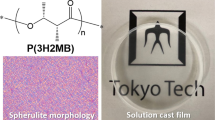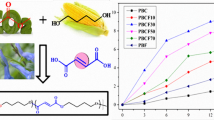Abstract
Polyolefin plastics are widely used due to their low cost and outstanding properties, but their environmental persistence presents a major societal challenge. Polyhydroxyalkanoates (PHA) are biodegradable substitutes for polyolefins, but their high cost and thermal instability are impediments to their widespread application. Here we report a series of methylated polyhydroxybutyrates, poly(3-hydroxy-2-methylbutyrate)s, which are structurally inspired by natural PHAs. The cis homopolymers exhibit tacticity-independent crystallinity, which allows for the discovery of high-melting, thermally stable and mechanically tough copolymers, and a full range of polyolefin-like properties can be further achieved by tailoring the cis/trans ratio of the repeating units. Moreover, these materials can be synthesized from inexpensive carbon monoxide and 2-butene feedstocks, and they can be chemically recycled or upcycled at their end of life. The versatile properties, abundant feedstocks and end-of-life utility of this family of polyesters will enable a powerful platform for the discovery of sustainable alternatives to polyolefin plastics.

This is a preview of subscription content, access via your institution
Access options
Access Nature and 54 other Nature Portfolio journals
Get Nature+, our best-value online-access subscription
$29.99 / 30 days
cancel any time
Subscribe to this journal
Receive 12 print issues and online access
$259.00 per year
only $21.58 per issue
Buy this article
- Purchase on Springer Link
- Instant access to full article PDF
Prices may be subject to local taxes which are calculated during checkout




Similar content being viewed by others
Data availability
The data supporting the findings of this study are available within the paper and its Supplementary Information. Crystallographic data for the structure of B-HMDS reported in this Article have been deposited at the Cambridge Crystallographic Data Centre, under deposition no. CCDC-2135622. Copies of the data can be obtained free of charge via https://www.ccdc.cam.ac.uk/structures/. Source data are provided with this paper.
References
Elhacham, E. et al. Global human-made mass exceeds all living biomass. Nature 588, 442–444 (2020).
Borrelle, S. B. et al. Predicted growth in plastic waste exceeds efforts to mitigate plastic pollution. Science 369, 1515–1518 (2020).
Geyer, R., Jambeck, J. R. & Law, K. L. Production, use and fate of all plastics ever made. Sci. Adv. 3, e1700782 (2017).
Jambeck, J. R. et al. Plastic waste inputs from land into the ocean. Science 347, 768–771 (2015).
Müller, H. M. & Seebach, D. Poly(hydroxyalkanoates): a fifth class of physiologically important organic biopolymers? Angew. Chem. Int. Ed. Engl. 32, 477–502 (1993).
Sudesh, K., Abe, H. & Doi, Y. Synthesis, structure and properties of polyhydroxyalkanoates: biological polyesters. Prog. Polym. Sci. 25, 1503–1555 (2000).
Ajellal, N. et al. Polymerization of racemic β-butyrolactone using supported catalysts: a simple access to isotactic polymers. Chem. Commun. 46, 1032–1034 (2010).
Tang, X. & Chen, E. Y.-X. Chemical synthesis of perfectly isotactic and high melting bacterial poly(3-hydroxybutyrate) from bio-sourced racemic cyclic diolide. Nat. Commun. 9, 2345 (2018).
Dong, X. & Robinson, J. R. The role of neutral donor ligands in the isoselective ring-opening polymerization of rac-β-butyrolactone. Chem. Sci. 11, 8184–8195 (2020).
Westlie, A. H., Quinn, E. C., Parker, C. R. & Chen, E. Y.-X. Synthetic biodegradable polyhydroxyalkanoates (PHAs): recent advances and future challenges. Prog. Poly. Sci. 134, 101608 (2022).
Noda, I., Lindsey, S. B. & Caraway, D. in Plastics from Bacteria Vol. 14 of Microbiology Monographs (ed. Chen, G.-Q.) 237–255 (Springer, 2010).
Tang, X. et al. Biodegradable polyhydroxyalkanoates by stereoselective copolymerization of racemic diolides: stereocontrol and polyolefin‐like properties. Angew. Chem. Int. Ed. 59, 7881–7890 (2020).
Tang, X., Shi, C., Zhang, Z. & Chen, E. Y.-X. Toughening biodegradable isotactic poly(3-hydroxybutyrate) via stereoselective copolymerization of a diolide and lactones. Macromolecules 54, 9401–9409 (2021).
Tang, X., Westlie, A. H., Watson, E. M. & Chen, E. Y.-X. Stereosequenced crystalline polyhydroxyalkanoates from diastereomeric monomer mixtures. Science 366, 754–758 (2019).
Jost, V. Packaging related properties of commercially available biopolymers—an overview of the status quo. Express Polym. Lett. 12, 429–435 (2018).
Kobayashi, T., Yamaguchi, A., Hagiwara, T. & Hori, Y. Synthesis of poly(3-hydroxyalkanoate)s by ring-opening copolymerization of (R)-β-butyrolactone with other four-membered lactones using a distannoxane complex as a catalyst. Polymer 36, 4707–4710 (1995).
Füchtenbusch, B., Fabritius, D. & Steinbüchel, A. Incorporation of 2-methyl-3-hydroxybutyric acid into polyhydroxyalkanoic acids by axenic cultures in defined media. FEMS Microbiol. Lett. 138, 153–160 (1996).
Watanabe, Y., Ishizuka, K., Furutate, S., Abe, H. & Tsuge, T. Biosynthesis and characterization of novel poly(3-hydroxybutyrate-co-3-hydroxy-2-methylbutyrate): thermal behavior associated with α-carbon methylation. RSC Adv. 5, 58679–58685 (2015).
Furutate, S. et al. Biosynthesis and characterization of novel polyhydroxyalkanoate copolymers consisting of 3-hydroxy-2-methylbutyrate and 3-hydroxyhexanoate. J. Polym. Res. 24, 221 (2017).
Dong, H., Liffland, S., Hillmyer, M. A. & Chang, M. C. Engineering in vivo production of α-branched polyesters. J. Am. Chem. Soc. 141, 16877–16883 (2019).
Furutate, S., Abe, H. & Tsuge, T. Thermal properties of poly(3-hydroxy-2-methylbutyrate-co-3-hydroxybutyrate) copolymers with narrow comonomer-unit compositional distributions. Polym. J. 53, 1451–1457 (2021).
Yang, J.-C., Yang, J., Li, W.-B., Lu, X.-B. & Liu, Y. Carbonylative polymerization of epoxides mediated by tri-metallic complexes: a dual catalysis strategy for synthesis of biodegradable polyhydroxyalkanoates. Angew. Chem. Int. Ed. 61, e202116208 (2022).
Furutate, S. et al. Superior thermal stability and fast crystallization behavior of a novel, biodegradable α-methylated bacterial polyester. NPG Asia Mater. 13, 31 (2021).
Dunn, E. W. & Coates, G. W. Carbonylative polymerization of propylene oxide: a multicatalytic approach to the synthesis of poly(3-hydroxybutyrate). J. Am. Chem. Soc. 132, 11412–11413 (2010).
Dunn, E. W., Lamb, J. R., LaPointe, A. M. & Coates, G. W. Carbonylation of ethylene oxide to β-propiolactone: a facile route to poly(3-hydroxypropionate) and acrylic acid. ACS Catal. 6, 8219–8223 (2016).
Berndt, T., Kreipl, A. & Lenski, U. Epoxidation of 2-butene from raffinate 2 feedstock. Ind. Eng. Chem. Res. 49, 3957–3960 (2010).
Bond, J. Q., Alonso, D. M., Wang, D., West, R. M. & Dumesic, J. A. Integrated catalytic conversion of γ-valerolactone to liquid alkenes for transportation fuels. Science 327, 1110–1114 (2010).
Lin, L. et al. Quantitative production of butenes from biomass-derived γ-valerolactone catalysed by hetero-atomic MFI zeolite. Nat. Mater. 19, 86–93 (2020).
Kim, T. Y. et al. Gas-phase dehydration of vicinal diols to epoxides: dehydrative epoxidation over a Cs/SiO2 catalyst. J. Catal. 323, 85–99 (2015).
Song, C. W., Park, J. M., Chung, S. C., Lee, S. Y. & Song, H. Microbial production of 2,3-butanediol for industrial applications. J. Ind. Microbiol. Biotechnol. 46, 1583–1601 (2019).
Mahadevan, V., Getzler, Y. D. Y. L. & Coates, G. W. [Lewis Acid]+[Co(CO)4]− complexes: a versatile class of catalysts for carbonylative ring expansion of epoxides and aziridines. Angew. Chem. Int. Ed. 41, 2781–2784 (2002).
Schmidt, J. A. R., Mahadevan, V., Getzler, Y. D. Y. L. & Coates, G. W. A readily synthesized and highly active epoxide carbonylation catalyst based on a chromium porphyrin framework: expanding the range of available β-lactones. Org. Lett. 6, 373–376 (2004).
Schmidt, J. A. R., Lobkovsky, E. B. & Coates, G. W. Chromium (III) octaethylporphyrinato tetracarbonylcobaltate: a highly active, selective, and versatile catalyst for epoxide carbonylation. J. Am. Chem. Soc. 127, 11426–11435 (2005).
Rowley, J. M., Lobkovsky, E. B. & Coates, G. W. Catalytic double carbonylation of epoxides to succinic anhydrides: catalyst discovery, reaction scope and mechanism. J. Am. Chem. Soc. 129, 4948–4960 (2007).
Pavlov, O. S., Karsakov, S. A. & Pavlov, S. Y. 1-Butene and 2-butenes production using the positional isomerization of butenes catalyzed by sulfonic acid cation exchangers. Theor. Found. Chem. Eng. 44, 531–535 (2010).
Amgoune, A., Thomas, C. M., Ilinca, S., Roisnel, T. & Carpentier, J.-F. Highly active, productive and syndiospecific yttrium initiators for the polymerization of racemic β‐butyrolactone. Angew. Chem. Int. Ed. 45, 2782–2784 (2006).
Ajellal, N. et al. Syndiotactic-enriched poly(3-hydroxybutyrate)s via stereoselective ring-opening polymerization of racemic β-butyrolactone with discrete yttrium catalysts. Macromolecules 42, 987–993 (2009).
Carpentier, J.-F. Rare-earth complexes supported by tripodal tetradentate bis(phenolate) ligands: a privileged class of catalysts for ring-opening polymerization of cyclic esters. Organometallics 34, 4175–4189 (2015).
Kramer, J. W. et al. Polymerization of enantiopure monomers using syndiospecific catalysts: a new approach to sequence control in polymer synthesis. J. Am. Chem. Soc. 131, 16042–16044 (2009).
Rieth, L. R., Moore, D. R., Lobkovsky, E. B. & Coates, G. W. Single-site β-diiminate zinc catalysts for the ring-opening polymerization of β-butyrolactone and β-valerolactone to poly(3-hydroxyalkanoates). J. Am. Chem. Soc. 124, 15239–15248 (2002).
Ebrahimi, T., Aluthge, D. C., Hatzikiriakos, S. G. & Mehrkhodavandi, P. Highly active chiral zinc catalysts for immortal polymerization of β-butyrolactone form melt processable syndio-rich poly(hydroxybutyrate). Macromolecules 49, 8812–8824 (2016).
Schofield, A. D., Barros, M. L., Cushion, M. G., Schwarz, A. D. & Mountford, P. Sodium, magnesium and zinc complexes of mono(phenolate) heteroscorpionate ligands. Dalton Trans. 7, 85–96 (2009).
Ruiz de Ballesteros, O. et al. Thermal and structural characterization of poly(methylene-1,3-cyclopentane) samples of different microstructures. Macromolecules 28, 2383–2388 (1995).
Lee, L.-B. W. & Register, R. A. Hydrogenated ring-opened polynorbornene: a highly crystalline atactic polymer. Macromolecules 38, 1216–1222 (2005).
Corradini, P., Auriemma, F. & De Rosa, C. Crystals and crystallinity in polymeric materials. Acc. Chem. Res. 39, 314–323 (2006).
Shi, C. et al. High-performance pan-tactic polythioesters with intrinsic crystallinity and chemical recyclability. Sci. Adv. 6, eabc0495 (2020).
Kafle, N. et al. Roles of conformational flexibility in the crystallization of stereoirregular polymers. Macromolecules 54, 5705–5718 (2021).
Abe, H. Thermal degradation of environmentally degradable poly(hydroxyalkanoic acid)s. Macromol. Biosci. 6, 469–486 (2006).
Nishida, H., Shirai, Y. & Hassan, M. A. Highly selective transformation of poly[(R)-3-hydroxybutyric acid] into trans-crotonic acid by catalytic thermal degradation. Polym. Degrad. Stab. 95, 1375–1381 (2010).
Bigley, D. B. Studies in decarboxylation. Part I. The mechanism of decarboxylation of unsaturated acids. J. Chem. Soc 1964, 3897–3899 (1964).
Acknowledgements
We thank S. N. MacMillan (Cornell University) for help with X-ray crystallography. This work was supported by the Department of Energy (no. DE-FOA-0002414) and ExxonMobil. This work made use of the Cornell Center for Materials Research and the NMR Facility at Cornell University, which are supported by the NSF under awards DMR-1719875 and CHE-1531632, respectively. The funders had no role in study design, data collection and analysis, decision to publish or preparation of the manuscript.
Author information
Authors and Affiliations
Contributions
Z.Z. and A.M.L. designed and performed all experiments. G.W.C. directed the research. All authors prepared the manuscript.
Corresponding author
Ethics declarations
Competing interests
Z.Z., A.M.L. and G.W.C. are inventors on US provisional patent application 63/220,301, submitted by Cornell University, which covers the synthesis and characterization of PHMB. T.D.S. declares no competing interests.
Peer review
Peer review information
Nature Chemistry thanks the anonymous reviewer(s) for their contribution to the peer review of this work.
Additional information
Publisher’s note Springer Nature remains neutral with regard to jurisdictional claims in published maps and institutional affiliations.
Supplementary information
Supplementary Information
Supplementary materials and methods, synthetic procedures, Figs. 1–46 and Tables 1–16.
Supplementary Data 1
Crystallographic data for B-HMDS; CCDC no. 2135622.
Supplementary Data 2
Raw Excel data for the PXRD data of cis-PHMB with varied syndiotacticity.
Supplementary Data 3
Raw Excel data for the tensile measurements of all PHMB samples.
Source data
Source Data Fig. 3
Source data for the tensile measurements of PHMB copolymers and commercial polyolefins (Fig. 3c).
Rights and permissions
Springer Nature or its licensor (e.g. a society or other partner) holds exclusive rights to this article under a publishing agreement with the author(s) or other rightsholder(s); author self-archiving of the accepted manuscript version of this article is solely governed by the terms of such publishing agreement and applicable law.
About this article
Cite this article
Zhou, Z., LaPointe, A.M., Shaffer, T.D. et al. Nature-inspired methylated polyhydroxybutyrates from C1 and C4 feedstocks. Nat. Chem. 15, 856–861 (2023). https://doi.org/10.1038/s41557-023-01187-0
Received:
Accepted:
Published:
Issue Date:
DOI: https://doi.org/10.1038/s41557-023-01187-0



